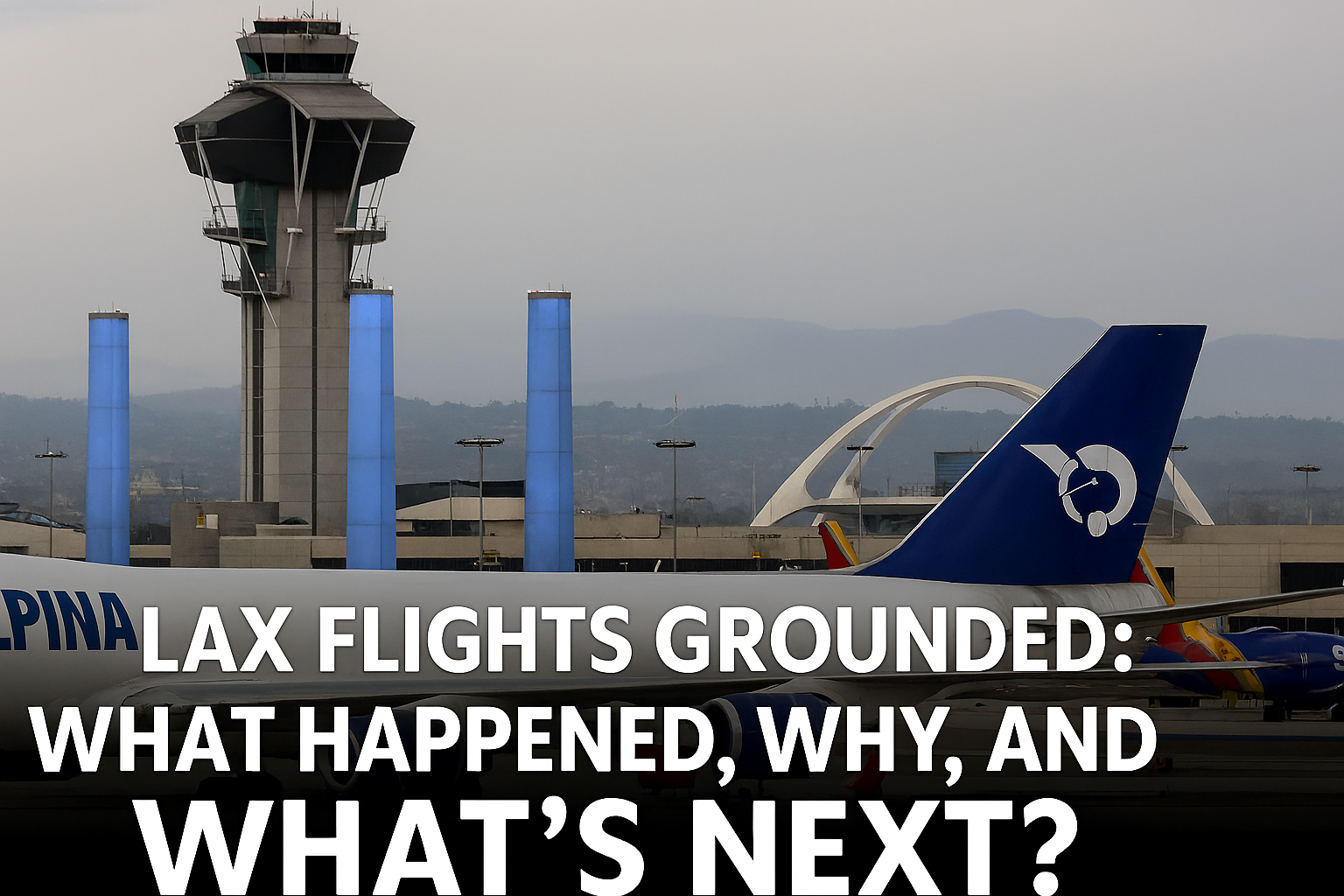Los Angeles International Airport (LAX), one of the busiest aviation hubs in the United States, experienced a temporary ground stop on October 12, 2025. Reports confirm that the Federal Aviation Administration (FAA) ordered all departures suspended after an unexpected equipment outage disrupted air traffic control systems. Gulf News+3Reuters+3KTWB Big Country 92.5+3 The outage disrupted hundreds of flights, caused cascading delays across the U.S. aviation network, and left many passengers stranded or scrambling for alternatives.
In this article, we break down:
- What precisely happened at LAX
- How airlines, regulators, and passengers responded
- The broader systemic challenges exposed
- What lessons and safeguards may follow
- Ongoing developments and expectations
What Happened — The Sequence of Events
The Ground Stop
On Sunday, October 12, 2025, the FAA declared a ground stop at Los Angeles International Airport. This means that departing flights were halted; arriving flights were either delayed or temporarily held. Gulf News+3Reuters+3KTWB Big Country 92.5+3 Reports suggest the issue was tied to a malfunction in an air traffic control equipment system — though the FAA hasn’t publicly disclosed which specific component failed. KTWB Big Country 92.5+3Aviation A2Z+3Bangla news+3
Airport officials said the outage was “swiftly contained” and that once technical teams restored normal functionality, operations gradually resumed. Aviation A2Z+2Bangla news+2 During the disruption, LAX’s tightly interwoven flight schedules began to unravel, with knock-on effects across domestic and international routes. Aviation A2Z+3rollingout.com+3Gulf News+3
Scale and Context
LAX handles approximately 1,500 flights per day, linking major U.S. hubs and international gateways. KTWB Big Country 92.5+4Gulf News+4India Today+4 Because of this volume and tight scheduling, even a short technical outage can ripple outward quickly. Aviation A2Z+2Bangla news+2
Complicating the picture is the fact that the U.S. aviation system is under strain due to staffing shortages at the FAA, spurred in part by the ongoing federal government shutdown. Some industry observers have linked this event to existing vulnerabilities in the system’s resilience. StartupNews.fyi+2Bangla news+2
Immediate Effects & Response

On Airlines and Flight Operations
Most major U.S. carriers with operations at LAX (Delta, American, United, Southwest, etc.) were affected. Departures were delayed, some flights canceled, and schedule disruptions cascaded across the national network as aircraft and crews became out of place. India Today+3StartupNews.fyi+3Aviation A2Z+3
Because flights are tightly scheduled and interlinked (e.g. aircraft coming from one city to LAX then onward elsewhere), even small delays propagate. Airlines attempted to rebook passengers, adjust gate allocations, and reassign crews as best they could under pressure.
On Passengers
Travelers faced uncertainty: some were stuck in terminals, others were unable to depart. Many scrambled to check flight status, changed connections, or sought alternatives (e.g. flights from nearby airports). News reports say thousands were affected. rollingout.com+2StartupNews.fyi+2
Airlines issued advisories urging passengers to stay in communication, check flight status before coming to the airport, and allow extra time for adjustments. StartupNews.fyi+2Bangla news+2
On the Broader Network
Because aviation is an interconnected network, the LAX outage caused ripple effects in other major U.S. airports. Some flights destined for LAX had to be held or rerouted; aircraft and crews diverted from other routes were out of position for their next segments. StartupNews.fyi+2Aviation A2Z+2
Thus, delays weren’t isolated to L.A. — they impacted U.S. airspace more widely.
Why Did This Happen? Root Causes and Systemic Factors
The LAX grounding reveals multiple layers of vulnerability in America’s aviation infrastructure. Let’s look into the potential technical failure, systemic pressures, and latent risks.
Equipment Malfunction — The Trigger
The proximate cause declared by the FAA is an equipment outage. But that phrase is broad: it could be anything from radar, communications, switching hardware, ground control computers, or a software glitch. KTWB Big Country 92.5+3Aviation A2Z+3Bangla news+3
Neither the FAA nor LA airport authorities have confirmed a cyberattack or malicious interference, though speculation has surfaced given the sensitive systems involved. TechStock² As of now, no confirmed evidence supports a cyber intrusion. Aviation A2Z+1
This event shows how even well-engineered systems are susceptible to single points of failure if not redundantly built or failover tested.
Staffing and Oversight Pressures
The U.S. air traffic control system has been under strain due to staffing shortfalls, fatigue, and budget constraints. Some of this is intensified by the current federal budget impasse, which has frozen personnel policies in many agencies. StartupNews.fyi+2Bangla news+2
With thinner margins for slack or buffer in operations, minor equipment disturbances have less margin to be absorbed before disruption. Maintenance windows and modernization projects may also be affected by reduced funding or deferred upgrades.
Aging Infrastructure and Technical Debt
Parts of the U.S. National Airspace System (NAS) run on systems that are decades old and need constant maintenance or modernization. According to academia, disruptions in the NAS have been increasing post-COVID, with loopholes in redundancy and anomaly detection. arXiv
When critical components are due for replacement or running near end-of-life, the system’s resilience to unexpected glitches weakens.
Network Interdependence & Scheduling Pressure
Modern airline scheduling is tightly interwoven for optimal usage of aircraft and crew. That leaves little flexibility for buffer or slack. Even a brief halting of operations in one hub like LAX propagates through the system, making recovery challenging.
Lessons Learned & Future Safeguards
From this incident, several lessons emerge. The aviation industry, regulators, and airports may draw on these to shore up resilience:
1. Redundancy and Failover Hardening
Key systems — radar, ground control, communications, switching — must have hot backups, cross-linked redundancy, and failover protocols tested regularly. Single failures should not cascade into system-wide shutdowns.
2. Robust Monitoring and Automated Fallbacks
Anomaly detection, real-time diagnostics, and automated safe-mode fallback systems can help isolate local faults before they require full ground stops.
3. System Modernization & Lifecycle Management
Timely upgrades and replacement of legacy systems must be prioritized. Adopting modular, scalable architectures would make patches, isolation, and recovery easier.
4. Staffing Margins & Training
Ensuring enough slack in trained personnel—even during budget squeezes—is essential. Cross-training, rotation, and preventive maintenance scheduling help reduce pressure. Also, ensuring that staffing isn’t compromised by external issues (e.g. government shutdowns) is key.
5. Crisis Preparedness & Communication Protocols
When such disruptions occur, clear, real-time communication with passengers, airlines, and media is critical to reducing confusion. Joint drills among FAA, airports, and airlines on outage scenarios can enhance coordination.
6. Network Resilience & Contingency Planning
Airlines should embed buffer in schedules and routing alternatives. Airports can collaborate to reroute traffic temporarily when one hub is affected.
Ongoing Developments & What to Watch
As of now, several investigations and follow-ups are underway:
- The FAA and LA airport authorities are expected to probe the exact component(s) that failed.
- Whether the outage was purely technical or had cyber or human error elements is being scrutinized.
- Airlines will publish updated operational impact figures over the next few days, including how many flights were canceled or delayed.
- Comparisons to past incidents (e.g. radar or communications failures in U.S. or Europe) will help calibrate safeguards.
- Policy-level discussions in Congress or at the Department of Transportation may revisit funding for air traffic infrastructure and modernization.
Passengers planning flights to or from LAX in the next few days are strongly advised to:
- Monitor airline communications and flight status continuously
- Allow extra buffer time before scheduled arrival at the airport
- Be prepared to rebook or accept alternate routing
- Stay in contact with travel insurance or airline customer service
Detailed Timeline (Example Reconstruction)
Below is a reconstructed timeline of how the LAX outage may have unfolded (based on news reports; subject to confirmation by investigators):
| Time Estimate | Event | Consequences / Notes |
|---|---|---|
| ~Early afternoon | Equipment outage begins in a critical ATC subsystem (e.g. ground control, switching) | Fault propagates; traffic coordination impacted |
| FAA detects anomaly / alerts local controllers | Preliminary attempts to isolate the fault | Degraded coordination, but still running on backup if available |
| FAA issues ground stop at LAX | Departures halted, arrivals delayed or held | Congestion builds, passengers notified |
| Technical crews dispatched | Begin diagnosis, repair, or failover switch | Possibly bring in specialist resources |
| Partial recovery / safe-mode checks | Some systems restored, basic coordination resumes | Flights begin to restart in phases |
| Full recovery | Normal operations resume, backlog remains | Airlines begin to catch up, schedule adjustments |
This kind of failure mode is consistent with previous aviation outages: small glitches magnify under load, especially when redundancy or buffer is limited.
Comparisons & Precedents
While large-scale ground stops at major airports are rare, aviation history has seen several similar disruptions:
- In the UK, radar or NATS system glitches have grounded flights or forced delays.
- Airlines sometimes ground fleets (or request ground stops) during IT system outages — e.g. Alaska Airlines experienced a full grounding due to IT issues earlier in 2025. Business Insider
- Past U.S. incidents (e.g. radar system or communication failures) have shown that even rich budgets don’t always insulate the system from surprises.
Those precedents underscore that technology, human systems, and contingency planning must all be sound.
Implications for Aviation & Travelers
For the Aviation Industry
- The LAX incident will be scrutinized by regulators, airlines, and system vendors alike.
- Contracts, SLAs (service level agreements), and maintenance regimes may be revisited.
- Insurance, liability, and compensation clauses might be reexamined in light of new risk assessments.
- Investment in resilient infrastructure, cybersecurity, and modernization could accelerate.
For Travelers
- Airlines may increasingly warn of “force majeure / technical disruptions” in booking terms.
- Some passengers may choose routes that avoid high-volume hubs like LAX in favor of smaller or alternative airports.
- Demand for travel insurance with broader coverage (including technical and infrastructure failure) may rise.
- Airlines and booking platforms may invest more in real-time disruption alerting and rebooking tools.
For Policy & Regulation
- Congressional oversight or DOT hearings may address FAA funding, maintenance backlogs, and infrastructure modernization.
- Setting minimum redundancy and failover standards for critical ATC systems might become more politically urgent.
- Budget stability (not being hostage to government shutdowns) is likely to return as a focal point in aviation discourse.
What to Watch in the Coming Days
- FAA / LAWA official report — The formal root cause analysis will shed light on the exact failure and the chain of events.
- Airline operational disclosures — Airlines will publish delayed and canceled flight data, and some may offer compensation or waivers.
- Policy responses — Whether Congress or aviation oversight bodies propose new funding or regulations.
- Follow-on technical audits — Vendors involved in ATC hardware or software may come under review.
- Passenger feedback and legal claims — If disruptions are prolonged, travelers may file claims or lawsuits, especially in connecting flights.
Conclusion
The recent LAX grounding is a stark reminder of how fragile even advanced aviation systems can be when technical, staffing, and modernizing pressures converge. What might seem like a “small glitch” can cascade into widespread disruption in a high-density hub like Los Angeles.
However, this incident also serves as a wake-up call: it highlights the urgency of redundancy, modernization, crisis preparedness, and appropriate funding discipline. For passengers and airlines alike, resilience and flexibility become not just competitive edges, but essential survival traits in the modern travel ecosystem.
